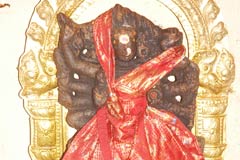Description
Hindus believe Veerbhada to be one of the aggressive abodes of Lord Shiva. The aggressive nature is inherited from the abode of Shiva (Rudra). The story behind the creation of Veerabhadra was to destroy the Yagna (fire of sacrifice) which was created for the wife of Shiva, Dakshayni (also known as sati) daughter of king Daksha, to which the Goddess self-immolated herself. The significance of Rudra was created by Goddess Daksha and also had a creation of Bhadrakali.
History
Mahesvar (name of Shiva) asked to demolish the hormone of sacrifice carried out by Daksha. The Words of Shiva served as honour to Veerabhadra, giving a danddavat to his almighty, Veerabhadra perched towards the fulfilment of the asked task; the reason behind the task was the yagna was being conducted against the will of Devi. Veerabhadra was accompanied by Goddess Rudrakali to witness the deed with all her train. Shiva dictated to the Brahamanasas, to carry forward the army and be fearless as a portion of him would be with them to guide them for the detention of yagna. Veerabhadra crouched in like a wild animal destroying everything possibly seen in front of him, as he was told to do so. He polluted the offering, broke the vessels for the puja, insulted the priest and splashed water into the yagna. Then, king Daksha was slaughtered. Screeching onto Indra trembling his throne the other Gods and returned to Kailasha.
Importance/Significance
During the swayamvara of Sati (dakshyani), the daughter of the king Daksha(man of all). Who grew up to a beautiful young woman, she fell in love with Shiva and set her heart to him, and worshipped him throughout. The king invited all the famous kings and princes from everywhere except Shiva to the swayamvara. To which Sati rebelled by calling out to Shiva and threw the garland of swayamvara in the air and it was found that Shiva was standing in the mid of the court wearing the garland. King(Daksha) was left with no other choice less than getting Dakshayani married to Shiva, who was dressed in tiger skin print that had been wrapped around his body, a jatta(bun of hair tied at the top of his head),with a stick with a damaru(a two side base music instrument, sign of infinity). The reason for Sati to self-immolate was given by her own father, as a homa for sacrificing a horse that was conducted by King Daksha where all the kings and God's were invited except Shiva, Sati wanted to go home uncontrollable by the love towards her parents, but instead of been invited she was insulted in front of all the guest which made her immolate into the yagna. The lifeless body saddened to the extent that he passed out the order of destroying the yagna, also the fire from the kunddh (pit for holy fire for sacrifice is burned) transformed into an abode of the Goddess known by Jwalamukhi Devi. All this made Shiva furious and he pulled out a lock of hair from his jatta and threw it to the ground which gave birth to Veerbhadra and also to Rudrakali. Veerbhadra's character sketch is of a dark huge tall man who touched heaven with three red burning eyes and hair like fire and he carried all scary weapons with a garland of skulls that he wore around his neck to double his powers.
Facts/Mythology
The temple symbolises the architecture of the time of the Vijayanagara kingdom. This temple is known to be erected during the 16th century for a deity named Veerabhadra to reside in. The Mandaps of the intricate temple have large pillars which are carved with large life-sized ancient dancers and musicians on it. The Nandi bull is the central attraction of the temple as it is placed in the middle of the mandapam, the ceiling is entirely decorated with mural paintings.
Festivals/Events/Gatherings

